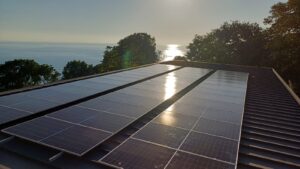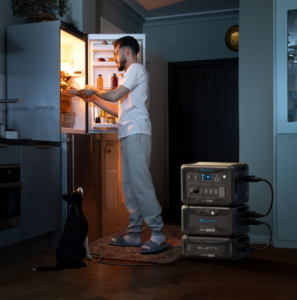If the local power grid suffers frequent power failures or may be susceptible to severe weather conditions, it is important to have backup power sources readily available. Fortunately, there are a variety of solutions that can be used to provide the required power supply when emergency incidents occur. A battery solar system or a backup generator are the most common solutions for such events. This guide will explore the pros and cons of these two options, helping owners of homes to make the right decisions and develop plans for their cases.
Whether it is solar power or backup generators, you will find that keeping your family safe and comfortable during an outage no longer seems to be a difficult task if you have an emergency power source at hand.
Solar Power

Solar energy is the fundamental pillar of renewable energy, as it makes the best use of the inexhaustible sun’s rays by employing various specialized devices. The solar power system, at its core, is a series of photovoltaic (PV) modules, each made up of many solar cells that convert sunlight into electrical energy. The system’s inverter(s), convert the direct current (DC) electricity generated by the modules into alternating current (AC) electricity, which can be used within a household. If used, batteries retain the energy that is not needed at that particular moment and make it available for use in the night when it is the sun is down.
Pros of Solar Power
Sustainable Energy
The solar power system produces electric energy without the emission of greenhouse gases and thereby makes the environment cleaner.
Renewable Resource
The sun’s energy is inexhaustible; hence, this energy source is reliable and consistent.
Economic Gains
Solar power is the only power alternative that ends up reducing electricity bills, delivering savings for homeowners and businesses over the long run.
Grid Independence
Users of the solar power systems can create their own electricity, thus decreasing their dependence on centralized power plants.
Extended Lifespan
Solar storage systems are long-lasting, typically functioning for 10-15 years, and many of them offer consistent energy storage throughout one daily cycle or more.
Cons of Solar Power
Initial Investment
The initial cost of installing solar panels is often a barrier to many people, although the falling prices are making solar storage more affordable.
Weather Dependency
Weather conditions and insolation fluctuations limit the consistency of renewable energy, especially solar power generation, and thus need overcapacity to make it available all the time. Although in Costa Rica the sun is shining almost every day so it is not a big concern for this country
Fossil fuel combustian Generator
![]() Generators provide a traditional backup solution that is already well known to many people. These machines work by converting one of several fuel sources, such as gasoline, diesel, propene or natural gas, into electrical energy during power outages.
Generators provide a traditional backup solution that is already well known to many people. These machines work by converting one of several fuel sources, such as gasoline, diesel, propene or natural gas, into electrical energy during power outages.
The generators need refueling regularly to keep running. They also need regular preventive maintenance, and need much more corrective maintenance than solar systems.
Pros of Generators
Low Upfront Costs
Traditional generators generally present less expensive start-up costs than other backup power sources, so that many homeowners can afford them without financial stress. Although LPG and natural gas units need significant investment in tanks and safety.
Availability and Accessibility
Generators are popular in many regions, and are widely available and easy to install and connect to the home
Cons of Generators
Environmental Impact
Generators are not environmentally friendly since they emit dangerous gases while operating and hence contribute to air pollution as well as increase the carbon footprint of the residences that rely on them for emergency power.
Noise Pollution
Generators are often noisy while being operated and especially in Costa Rica where one enjoys nature, the noise can be very disturbing.
Maintenance and Re-fueling Challenges
Generators are subject to frequent maintenance to guarantee their high level of efficiency and a number of tasks, oil changes and components inspection, which are not necessarily easy for homeowners who do not have a technical background. Refueling can also be challenging if you live far from civilization.
Long-Term Costs
Although traditional generators are relatively cheap to purchase, they will continue to have high costs during their lifetimes as they may require regular maintenance, fuel consumption, and repairs, which in sum can be more expensive than alternative backup power sources.
Cost savings
Generators are more expensive per unit of energy provided (kWh) than the power grid. So generators may serve as a backup, but cannot be used to save money on the electricity bill.
Solar System VS Generator: Cost Comparison
The decision between a solar system and a generator will have a direct influence on the cost of powering your home or business during blackouts or when you are off grid. An average standard solar power system installation for a house is estimated to be anywhere from $15,000 to $25,000, depending on the system’s size and complexity. After the initial installation, the running costs of solar systems remain very low with very little maintenance required.
On the contrary, a typical residential grade standby generator may cost around $5,000 to $15,000, not including installation expenses. Other than that, the generators need fuel to run and that creates more operating expenses. A generator with a capacity of about 10 kilowatts may consume up to $30 to $50 worth of fuel daily when there are long power outages.
Although it may involve a bigger initial investment, the solar system is the most cost-efficient in the long run, in addition to the fact that it has environmental benefits, as well as independence from fuel reliance. The investment will pay back over time, due to the savings on the utility bill. Therefore, it is a good choice for those who are interested in reliable power solutions. In Costa Rica the payback time is about seven to eight years.
Solar System VS Generator: Output
The most important factor to consider when comparing different power solutions, such as solar systems and generators, is the output they provide. Let’s delve into the details:
Solar System Output
The output of a typical residential solar system is measured in kilowatts (kW). It may vary based on the quantity of modules and their watt-peak rating, sunlight hours, inclination, orientation and shading. The electricity produced by a 5kW solar inverter with a 5-kW-peak of solar modules can range between 6,000 to 8,000 kWh annually. This makes it possible to cover a large share of the average family’s energy use, especially in day-time. The solar system output does not depend on load demand, but on the sun’s position in the sky. So, it needs a mechanism to balance production with demand. That can be the power grid, under a net-metering scheme, or with batteries that store excess energy, and release it when needed later.
Generator Output
Generators are rated in kilowatt (kW), where the numbers indicate the maximum power output. For instance, a 5-kW generator can provide you with up to 5,000 watts of uninterrupted power. Nevertheless, the actual power output from the generator’s operation may differ due to load and availability of fuel. So, the generator output depends on the demand from the loads. And with that, the fuel consumption. A generator uses approximately 0.3 liters of gasoline per kWh generated. With a gas price of 600 colones/liter, that comes down to almost US$ 0.40 per kWh. The utility price is about US$ 0.25 per kWh. And solar US$ 0.00.
Comparing Output
Regarding production, solar power systems generate unlimited emission-free power during daytime, and any excess energy is stored in batteries for the night. Generators, on the contrary, can supply the needed power at any time, but their efficacy is determined by the availability of the fuel, and they need to be refueled to keep on running over a long time.
Solar Home Battery Backup Recommendations
BLUETTI AC300 + B300K | Home Battery Backup

The BLUETTI AC300 + B300K Home Battery Backup is a modular power system. The battery is made up of a maximum of four B300 battery modules per unit, thereby providing a standard of 12.288 Wh, which means you can take care of your family’s basic needs for a few days during emergencies. In addition, unlike the traditional methods, this module is capable of 2,400 watts of solar charging input and advanced MPPT control, and it can recharge a B300K module in only 1,5 hours of sunlight. Well-fitted with a 3,000-Watt pure sine inverter and adjustable AC charging rates, this versatile device can be used in every situation. The BLUETTI AC300 not only provides you with power during blackouts, but it can also be your best friend for full-time solar living, leaving you worry-free about having energy for your needs.
BLUETTI EP900 WHOLE HOME BACKUP

The Bluetti EP900 Whole Home Backup boasts a revolutionary integrated design with ample power and capacity. It can be installed with 2, 3 or 4 LFP batteries of 5kWh each. The power output is 240/120V and 9000W continuous, enough to power the whole house including air conditioners. The solar input is also 9000W, with the possibility to connect to 13 kWp of solar modules, good for generating around 20.000 kWh/year. It’s also possible to install two systems in parallel, doubling all these specifications It’s efficient tower design takes up little space and gives it a neat and clean look. The system can be used with existing solar as well. And a fossil fuel generator can be integrated so that it comes on automatically when the batteries are low.
Final Thoughts
Solar storage systems need a higher up-front investment, but ends up being cheaper over time, in comparison with a fossil fuel generator. It is also more environmentally friendly and quiet. The decision between solar and generator is an important one. The long-term positive impacts and sustainability of solar makes it the preferred choice. Using solar power, which is a renewable energy resource from the sun, the goal of independence from fossil fuels is reached and has negligible environmental effects. Generators provide the required power instantaneously; however, they are accompanied by continuous expense and greenhouse gases. A good way to go along with the trend of green power is to choose solar. In this way, the cost of energy is kept low, the environment will be protected, and the dependency on a diminishing resource will be reduced. Some systems, like the Bluetti EP900, can also integrate a generator, which it will turn on when the batteries are low. This generator can be much smaller than in a “generator only” scenario, because the EP900 system will absorb the power demand fluctuations. Best of both worlds!
